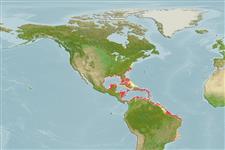Teleostei (teleosts) >
Scombriformes (Mackerels) >
Scombridae (Mackerels, tunas, bonitos) > Scombrinae
Etymology: Scomberomorus: Latin, scomber = mackerel + Greek, moros = silly, stupid (Ref. 45335).
More on author: Bloch.
Environment: milieu / climate zone / depth range / distribution range
Ecology
Marine; reef-associated; oceanodromous (Ref. 51243); depth range 1 - 20 m (Ref. 9710), usually 1 - ? m (Ref. 55288). Tropical; 41°N - 24°S, 99°W - 34°W
Western Atlantic: Massachusetts, USA to Brazil, including the Bahamas and West Indies.
Length at first maturity / Size / Weight / Age
Maturity: Lm 40.5, range 38 - ? cm
Max length : 183 cm TL male/unsexed; (Ref. 26340); max. published weight: 7.8 kg (Ref. 4699)
Dorsal spines (total): 16 - 18; Dorsal soft rays (total): 15 - 19; Anal spines: 0; Anal soft rays: 15 - 20; Vertebrae: 47 - 48. Interpelvic process small and bifid. Lateral line gently curving down toward caudal peduncle. Intestine with 2 folds and 3 limbs. Swim bladder absent. Body covered with small scales. Anterior third of first dorsal fin black. Pelvic fins relatively long. Sides silvery with one long mid-lateral stripe and with several rows of yellow-orange streaks of variable length and small yellow spots above and below the stripe.
Most abundant in clear waters around coral reefs, occasionally forming schools. Feeds on clupeoids (Harengula, Jenkinsia and Opisthonema) and atherinids (Allanetta [= Craterocephalus), squids and shrimps. Good food and game fish (Ref. 5521). Utilized fresh, smoked and frozen; consumed pan-fried, broiled and baked (Ref. 9987). Sometimes called the "Painted Mackerel" (Ref. 13442).
Collette, B.B. and C.E. Nauen, 1983. FAO Species Catalogue. Vol. 2. Scombrids of the world. An annotated and illustrated catalogue of tunas, mackerels, bonitos and related species known to date. Rome: FAO. FAO Fish. Synop. 125(2):137 p. (Ref. 168)
IUCN Red List Status (Ref. 130435: Version 2024-1)
Threat to humans
Reports of ciguatera poisoning (Ref. 9987)
Human uses
Fisheries: minor commercial; gamefish: yes
Tools
Special reports
Download XML
Internet sources
Estimates based on models
Preferred temperature (Ref.
123201): 23.4 - 28.1, mean 27.3 °C (based on 977 cells).
Phylogenetic diversity index (Ref.
82804): PD
50 = 0.5000 [Uniqueness, from 0.5 = low to 2.0 = high].
Bayesian length-weight: a=0.00977 (0.00522 - 0.01830), b=3.01 (2.85 - 3.17), in cm total length, based on LWR estimates for this species & Genus-body shape (Ref.
93245).
Trophic level (Ref.
69278): 4.5 ±0.4 se; based on diet studies.
Resilience (Ref.
120179): Medium, minimum population doubling time 1.4 - 4.4 years (Fec=160,000; assuming tm=2-4).
Prior r = 0.37, 95% CL = 0.25 - 0.56, Based on 1 data-limited stock assessment.
Fishing Vulnerability (Ref.
59153): Very high vulnerability (90 of 100).
Climate Vulnerability (Ref.
125649): High vulnerability (57 of 100).
Nutrients (Ref.
124155): Calcium = 8.08 [3.23, 27.36] mg/100g; Iron = 0.327 [0.126, 0.834] mg/100g; Protein = 21.2 [19.7, 22.7] %; Omega3 = 0.113 [0.070, 0.193] g/100g; Selenium = 39.6 [12.7, 130.5] μg/100g; VitaminA = 66.6 [12.9, 341.5] μg/100g; Zinc = 0.541 [0.330, 0.918] mg/100g (wet weight);
